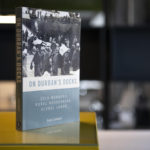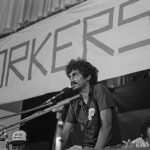New Books | Fighting apartheid on the Durban docks
Dockworkers kept their elected representative secret so that the state could not persecute any individual in the union. This strategy was later widely adopted during strikes.
Author:
4 April 2019

The way that dockworkers used industrial action in the seaport of Durban to advance working class aims and to fight apartheid was both effective and instructive. Between 1949 and 1959, they went on strike five times, with their 1954 strike prompting a workers’ body in the then Transvaal to declare that “a victory for the dock workers is a victory for the entire working class of South Africa”.
This is an edited extract from Dockworker Power: Race and Activism in Durban and the San Francisco Bay Area by Peter Cole (University of Illinois Press, 2018).
Docker actions sought to improve the lives of a vital part of Durban’s black working class and contributed to the struggle against apartheid – social movement unionism without a formal union. Their actions are especially notable, for they occurred despite drastic efforts by employers and the state to contain them. Indeed, dockers struck five times in 11 years, in 1949, 1954, 1956, 1958 and 1959. They did so with Zulu Phungula as their leader and after his banishment. They struck for wage hikes but also to improve hiring conditions and to decasualise the waterfront – to end the togt or casual labour system. Simply put, no other group of black workers in Durban did what the dockers did. Nationwide, perhaps only gold miners around Johannesburg proved as militant. Each time the dockers rose, repression quickly followed with firings, police arrests and beatings, and threats of deportation. Attacks against Durban’s dockers, particularly in 1958 and 1959, also foreshadowed broader repression against the anti-apartheid movement in the early 1960s, resulting in a largely quiescent black population later in the decade.
Related article:
The emergence of apartheid merged with surging anti-communism, early in the global Cold War, to further limit the options of black activists and white allies, especially communists, fighting for equality. The great comparative historian George Fredrickson wrote, “Although they never achieved the mass support that the Garvey movement or the Industrial and Commercial Workers Union (ICU) had attracted during the 1920s, communists did manage to play a significant role in the struggle against white racism.” Scholar and activist Bernard Magubane, whose father worked on the Durban docks, recalled: “My father and his friends responded warmly to the fighting stand taken by communists on behalf of African rights. They referred to the members of the Communist Party as Amabomvu – the Red Ones.” The Communist Party of South Africa (CPSA) and communists across Africa, as well as in the Soviet Union, provided major support for independence movements throughout the developing world, including South Africa. Almost immediately upon assuming power, though, the Nationalist Party undertook a massive campaign against the CPSA, hand-in-glove with the first wave of apartheid legislation.
As historian Nicholas Grant recently wrote, “the National Party regularly framed the containment of black protest in South African in the language of anti-communism.” Most drastically, the Suppression of Communism Act of 1950 banned the CPSA and defined communism in the broadest of possible terms; literally, a communist was anyone who advocated “any political, industrial, social or economic change within the Union [of South Africa] by the promotion of disturbances or disorder.” Just prior to this law’s passage, the CPSA dissolved itself but, in 1953, returned as the South African Communist Party and operated underground until it was unbanned in 1990.
Fighting white minority rule
Durban dockers agitated against white minority rule for decades but became increasingly involved as apartheid’s grip expanded in the 1950s. Billy Nair, a legendary Durban communist and labour and anti-apartheid activist, summarised the dockers’ vital role: “This has a history because in the 1930s and 1940s, the workers themselves organised secretly. This is largely because one of their leaders exposed himself by actually becoming a spokesman, a famous Zulu Pungula [sic]. When it was found that he was the ringleader in organising the workers he was actually deported, never to come back to Durban again.
The workers learnt a bitter lesson from this and decided to organise secretly so their leaders were never exposed again. But annually, especially during the peak period, when the ships used to dock in the Durban harbour by the hundreds, the workers used to strike at the right moment, in order to push their demands. The workers were met with hostility on the part of the authorities. Police, sometimes the army, were called and even the security [force] of the Stevedoring Company was also let loose, to bash their heads and pressure them to get back to work and so on. Force was one of the themes that ran through the reaction to workers’ struggles for improvements.”
Dockers as political actors
Although African residents of cities had much to consider before protesting, dockers acted boldly and repeatedly on the job – where they had power – understanding themselves as political actors. Tina Sideris, who interviewed some in the early 1980s, reiterated: “The dockworkers faced some very big problems. One of the biggest problems was the police. During every struggle the government sent the police to break strikes. Sometimes they even sent the army to force workers to go back to work.” Whites also understood that black working-class power had the potential to upend apartheid. BJ Schoeman, a prominent National Party politician who served as minister of labour in the House of Assembly, said as much as early as 1953: “It is obvious that the stronger the Native trade union movement becomes, the more dangerous it would be to the Europeans in South Africa … We would probably be committing race suicide if we give them that incentive.”
Related article:
In 1949, after the horrible Cato Manor riots, Durban was predictably tense. Nevertheless, Zulu Phungula, newly returned after his five-year banishment, issued “a notice to all workers in the province of Natal” urging them not report to work on 1 May unless they received £1.5 per day. Eight hundred dockers responded by striking the day after May Day and black workers in related industries also struck. These actions occurred despite Phungula’s arrest. Rowley Israel Arenstein, a well-known communist Jewish lawyer in Durban, served as his defense attorney; Phungula stood little chance. Once again, Phungula was banished to Ixopo, this time for 10 years and, as far as is known, he never returned. The city government also reduced the number of “surplus” Africans by more strictly limiting the entry of Africans into Durban, which hurt employers of togt labour. The national government also aided the employers, when it introduced labour bureaus in rural areas and agreed that togt employers need not register their workers daily.
Novel tactics
The banishment of Phungula, no doubt, gave the dockers serious pause and resulted in an ingenious new tactic that tens of thousands of black workers in Durban copied in 1973. As Sideris wrote, on the basis of interviews conducted in the early 1980s, “The dockworkers learnt one big lesson from their fight in the 1940s. They saw what the government did to their leaders. So they had to find a way to protect their leaders. In the 1950s they made a plan.” That plan turned out to be as simple as it proved effective, “When we are talking to our employers the government interferes. The man we want to speak for us has been taken away. We are still looking for him. [Henceforth] we won’t have spokesmen.”
Dockers first refused to select leaders during their 1952 strike. The Native Affairs Commissioner in Durban, R Watling, reported on this strategy to his superior: “I requested the gathering to elect two or three spokesmen to appear and put their case to the Council at the meeting to be held on Monday next. This was rejected on the ground that a spokesman would be victimised and deported from Durban.” As an alternative, Watling arranged a gathering at which employers and government officials addressed a group of “some 400 to 500 Natives … [who] were most orderly and well behaved.” Hemson later discussed this tactic: “These organisational forms were able to survive longer among these workers than among those with more formal methods of organisation.” They continued using this strategy and, in 1973, the workers at Coronation Brick – widely credited for launching the Durban Strikes – adopted an identical approach.
Related article:
In 1954, nearly 3 000 waterfront workers – mostly togt but also some members of the South African Railway and Harbour Workers Union – struck, marking the largest industrial action of 1950s Durban to that date. Their primary demand was a raise, of nearly 50%, though they also asked to be represented by their banished leader, Phungula. It is interesting to note that the government blamed the African National Congress, a South African police official claiming, “there is little doubt that this organisation had much to do with bringing about the stoppage of work”. No extant evidence for ANC involvement exists.
Under the newly passed Native Labour (Settlement of Dispute) Act, African workers could not legally strike, and so the dockers were threatened with firings; the togt workers, as casuals, legally were not striking, however, and so they were within their rights in refusing to return to work. Employers and the Central Native Labour Board (CNLB) then threatened to evict the workers from their hostels, asserting that togt workers were required to be on call for work as a condition of housing. After facing down both barrels of this employer-state shotgun, the dockers returned to work, but not before the CNLB “granted” a raise of nearly 20% – a major gain and evidence that employers understood that their workers possessed some power. Yet, in a final show of employer strength, nearly 100 strikers were fined one day’s wages for their actions. Further proof of this strike’s national import came from the Transvaal Council of Non-European Trade Unions and Congress of Democrats, the latter of which declared, “a victory for the dock workers is a victory for the entire working class of South Africa.”



